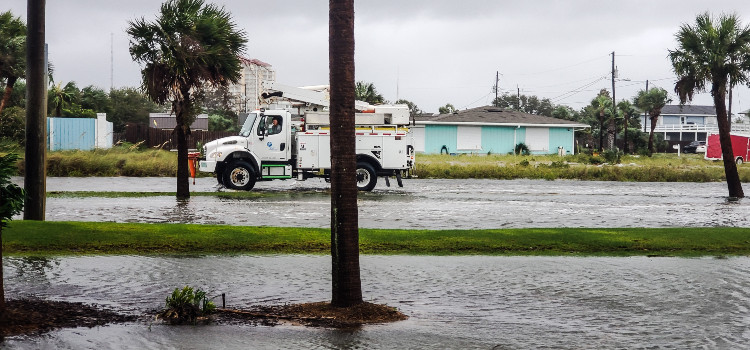Have you ever watched the local weather on the news and wondered how the categories of a hurricane are determined?
How do meteorologists categorize the severity of a hurricane or tropical storm?
Meteorologists use the Saffir-Simpson wind scale. The scale is an objective scale used to estimate hurricane strength.
Wind speed is measured in knots, which is a nautical mile per hour. The higher the wind speed, the more damage it does. Low-level winds can topple trees and do minor damage to buildings; high-level winds can cause major destruction to buildings, power lines, and large objects.
The scale is based on barometric pressure (in Millibars), which measures the force of winds pushing against the surface of the Earth.
Contents
What Is The Saffir-Simpson Wind Scale?
The Saffir-Simpson hurricane wind scale is an objective scale that categorizes hurricanes according to their sustained wind speed in miles per hour. The categories are based on the amount of damage a hurricane can cause.
The categories are:
- Category 1 – 74-95 mph. The category is applied to hurricane’s that have minimal damage
- Category 2 – 96-110 mph. This category is applied to hurricanes with severe damage and often short duration.
- Category 3 – 111-129 mph. This category is applied to hurricanes with extensive damage and often long duration.
- Category 4 – 130-157 mph. This category is applied to hurricanes with devastating damage and often long duration.
- Category 5 – 157+ mph. This category is applied to major hurricanes with catastrophic damage and typically long duration.
It was invented in the early 1970’s by Dr. Herbert Saffir and Robert Simpson, both of whom are hurricane researchers, although neither one ever used the term “Saffir-Simpson” to describe the scale.
The name stems from Dr. Saffir’s time spent at the United States Weather Bureau. While there, he saw that further improvements in forecasting techniques were needed beyond simply measuring cloud cover, pressure and temperature observations made at weather stations.
Is The Saffir-Simpson Scale Accurate?
Not all hurricanes are assigned to the same category. The wind speed during the hurricane’s life determines which category it is placed in. Also, to be fair, some categories (such as Category 1 and 3) do not apply to every hurricane.
The scale for the intensity of hurricanes also does not take flooding or storm surges in account. Considering that hurricanes sometimes slow down and stall after hitting land, the wind speed does not always indicate the level of damage caused.
Also, some hurricanes and tropical cyclones move so slowly that they barely produce any wind at all. Hurricane Gilbert of 1988 was a perfect example. It made landfall in Mexico and remained along the coastline for almost a week while it dumped record amounts of rain. The hurricane is still considered one of the worst to hit Mexico in its history.
Why Is The Saffir-Simpson Scale Flawed?
During tropical storm and hurricane season, the Saffir-Simpson scale gets plenty of criticism for being too simplistic since it only takes wind speed into account. This is because it can be difficult to accurately categorize hurricanes that travel slowly and stall over land.
Hurricane Gilbert in 1988 is a perfect example. It made landfall in Mexico and remained along the coast for almost a week while it dumped record amounts of rain. Although its average sustained wind speed was only around 42 mph, its slowing down and finally moving out to sea kept it off the scale.
Thus, there is some controversy over the Saffir-Simpson scale.
Why Is The Saffir Simpson Scale Used?
The Saffir-Simpson scale is still used because it is an easy way to categorize hurricanes. Meteorologists can use the scale to quickly communicate level of damage hurricanes are estimated to cause.
The scale is still used in spite of some flaws because it offers the most realistic prediction of wind speed. It factors in more than just wind speed while minimizing subjectivity while coming up with its estimate on damage caused by a hurricane.
What Scale Was Used Prior To The Saffir-Simpson?
Prior to the creation of the Saffir-Simpson scale, the Beaufort Scale was used. The scale is not as accurate and offers more subjectivity than the Saffir-Simpson scale.
It is based on wind speed and an estimate of damage caused by a hurricane’s winds. This is because it uses subjective estimates given by people who see how a hurricane manifests itself on land.
Conclusion
The Saffir Simpson Wind Scale is a useful tool to determine the strength of a hurricane, but it’s limitations should not be ignored. It can be especially misleading for those who think that the scale is an indication of how deadly a hurricane will prove to be.
It is important to remember that wind speed alone does not always determine the severity of a hurricane. It also takes rainfall, storm surge, and flooding conditions into account. The Saffir-Simpson scale does not take these factors into account because they are too difficult to accurately predict.
More importantly, there are other indicators that can indicate how destructive a given hurricane may become.

